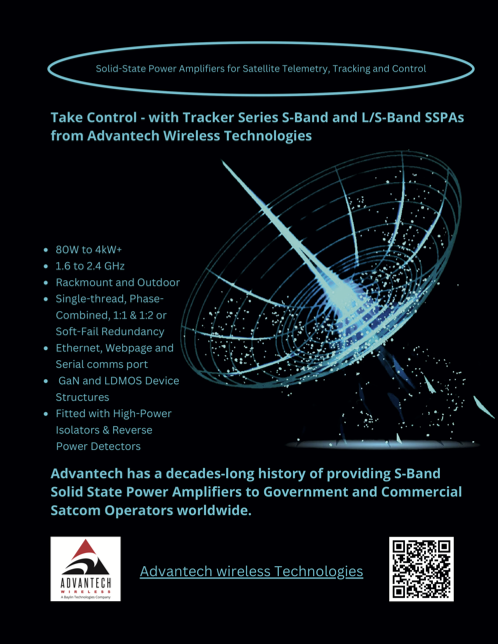The recent boom in the satellite industry has created a new Non-Terrestrial Network (NTN) ecosystem, and with it, a changed NTN economy as businesses compete to offer global, universal and affordable connectivity.

As an array of ambitious players enter the market, we believe that harnessing deep tech innovation will be crucial for you to compete in this bustling new landscape.
My colleagues at Cambridge Consultants (CC) and I deep dive into this topic in our latest whitepaper, Assembling rebel alliances to compete in the new NTN economy, which you can read in full at this direct infolink. In the whitepaper, we outline the three areas that you must address to assert yourself as a satellite market leader, namely:
• How you can understand, influence and creatively innovate using the latest standards.
• How developing strategic partnerships can accelerate your journey to market leadership.
• The importance of harnessing deep tech innovation to differentiate your business.
I covered the importance of forming strategic, collaborative partnerships in my last article for SatMagazine. This time, let’s focus in on some of the exciting deep tech areas we’re exploring, from free space optics to Artificial Intelligence (AI), that we believe will prove instrumental to differentiating yourself as a true, NTN market leader.
Deep tech
innovations you
need to know about
Being aware of the most cutting-edge technological innovation, particularly in areas of deep tech, is no small part of staying ahead of the curve by enabling new offerings, services and opportunities that can meet the future of satellite communications.
What is deep tech? At CC, deep tech represents a mindset; a bold strategy that harnesses a combination of radical science and engineering to do what no-one else has before. The transformative solutions this approach produces grant you an unassailable commercial advantage through unique technology and protected IP.
Vitally, we recognize that achieving this success can’t be done with just one field of expertise. Our challenge-orientated deep tech approach brings multidisciplinary teams together to unlock creative and unique technological solutions that will put you ahead of the competition.
Let’s explore how these state-of-the-art technologies can keep your service offering at the forefront of innovation:
Free Space
Optics (FSO)
While the concept of using light for communication is nothing new, modern Free Space Optics (FSO) technology is a relatively recent area of innovation that has only been made commercially viable over the past few years, thanks to significant advancements in laser technology and optical components. With these advancements, FSO offers a transformative approach to data transmission by leveraging light propagation through free space to deliver unparallelled high- bandwidth and low-latency communications.
FSO can now transmit data over significantly longer distances and at higher speeds for both increased range and capacity, while also offering the improved resilience satellite operators need for interference-free operation in challenging environments. Meanwhile, the modular nature of FSO allows for seamless scalability, offering greater flexibility to meet growing data demands through future-proofed solutions. Additionally, as FSO doesn’t need extensive ground infrastructure, deployment can be both rapid and cost-effective.
While FSO is already receiving plenty of interest for industrial automation and military communications, it could be particularly game-changing for the satellite industry due to its ability to provide low-latency, high bandwidth links through the atmosphere to the ground. This is essential for the meaningful and timely exploitation of sensor data.
Take the example of satellite monitoring for forest fires — if the satellite needs to orbit for hours or days before data can be transmitted to Earth, that data will no longer be useful by the time it reaches parties on the ground. FSO can solve this issue for space communication by increasing the amount of information possible to send quickly and reliably from a satellite to ground stations.
However, FSO technology faces challenges around atmospheric absorption, turbulence, and complications with pointing, tracking, and acquisition.
Weather conditions, particularly fog, smog, and clouds, can significantly impact FSO communications.
The team at CC are working to address these challenges with the development of a model that utilizes weather, geographic, satellite positioning, and atmospheric data to optimize a global low-latency, high-bandwidth NTN. This model will compare the effectiveness of Radio Frequency (RF) links, FSO links or a combination to determine the best method for efficient data transmission. Ultimately, this will help businesses to optimize satellite constellations, reducing costs and assets while ensuring reliable service.
Artificial
Intelligence (AI)
When discussing important and influential current technologies, it’s impossible not to mention AI as its remarkable capabilities are progressively placed at the core of systems.
For NTNs, the potential of AI is endless, offering up the dynamic control and proactive optimization that could previously only be dreamed of becoming a reality. Next-generation AI-enabled ecosystems are set to become increasingly responsive, with advances in edge AI making systems smaller, faster, cheaper and more agile.
AI-driven autonomous networks will be transformative for the future of satellite, telecoms and beyond. Through autonomous, AI-driven networks, satellites can make autonomous decisions while in orbit based on real-time data and predefined rules, improving operational efficiency and reducing ground station dependency. Similarly, AI algorithms could autonomously optimize satellite orbits, directing the satellite to avoid collisions and perform complex maneuvers independently.
Indeed, all the technology I’ll list here can be empowered in some way by AI, with different AI models helping to align optics, signals and advanced processing for a more streamlined service.
Advanced antennas
and beamforming
innovation
Another vital area to highlight are the developments in advanced antenna technologies and beamforming, including phased-array antennas and smart antennas. These will be instrumental in optimizing the performance of NTNs, enhancing signal quality and coverage while improving overall network efficiency. Beamforming, the process of directing radio frequency signals toward specific users, isn’t a new technology, but it remains critical for NTNs. By directing signals with ultimate precision, beamforming optimizes signal strength and reduces interference, while multi-beam phased-array antennas can support multiple beams simultaneously for enhanced coverage and capacity.
Integrating AI with beamforming will further revolutionize the field, with advances in digital signal processing (DSP) are enabling the development of more complex beamforming algorithms that allow the real-time adaptation of beam patterns while accounting for changing channel conditions, user mobility and interference.
Meanwhile, strides are being made in antenna design through Generative Adversarial Networks (GANs), where algorithms fine-tune antenna parameters based on certain performance metrics. Similarly, the use of novel metamaterials, which are artificially engineered to hold unique electromagnetic properties, enable novel characteristics and provide a route to miniaturization, high gain and wide bandwidth.
Advanced signal
processing and
novel computation
architectures
Originally used for basic signal enhancement, Digital Signal Processing (DSP), Field-Programmable Gate Arrays (FPGAs), Application-Specific Integrated Circuits (ASICs) and advanced communication protocols have evolved into critical components for NTN performance, offering high-speed data processing and adaptable solutions.
Supporting sophisticated communications protocols and system efficiency, they allow for more robust and flexible NTNs through increased parallel processing power, reconfigurability and customization, hybrid architectures, protocol acceleration and power optimization. Advanced protocols also enhance communication efficiency through reduced latency and improved throughput, while both DSP and FPGAs support scalable solutions since they can be reprogrammed to adapt to new standards, protocols and growing data demands.
Meanwhile, AI can again play an important role. By combining DSPs and FPGAs for high-speed data processing with AI algorithms to optimize satellite constellation design and operations, there’s huge potential to predict satellite traffic patterns, optimize satellite orbits for maximum coverage and capacity and developing autonomous satellite swarm management systems for robust satellite constellation optimization.

These are just a few of the exciting areas of deep tech that we’re currently exploring, all of which will play central roles in the NTN economy in the years to come. It is through this deep tech innovation that you can unlock differentiation in your offering to gain a transformative commercial advantage over your competitors, offering your users a unique, cutting-edge service that they can’t get anywhere else.
From simulation and modelling to AI, machine learning, FSO and quantum, our fusion of skillsets offers you with a combined scientific, advisory and strategic viewpoint that will help you navigate this competitive and fast- moving new landscape.
Download our whitepaper, Assembling rebel alliances to compete in the new NTN economy, at this direct infolink to learn about our latest projects putting this technology into action and reach out to discuss how CC can help you achieve your goals. The future of NTNs is happening now, and together, we can help shape it.
www.cambridgeconsultants.com

Stewart Marsh
Author Stewart Marsh is the Head of Aerospace at Cambridge Consultants. With 20+ years of experience in aerospace and telecommunications, Stewart helps companies achieve technology breakthroughs that unlock transformative business value, including a world-first Push- to-Talk satellite service and a beyond visual line-of-sight UAV solution using low-power satellite technology.
LinkedIn contact
Email: stewart.marsh@cambridgeconsultants.com


